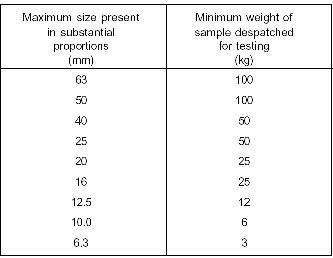SIEVE ANALYSIS
Sieve analysis helps to determine the particle size distribution of the coarse and fine aggregates.This is done by sieving the aggregates as per IS: 2386 (Part I) – 1963. In this we use different sieves as standardized by the IS code and then pass aggregates through them and thus collect different sized particles left over different sieves.
The apparatus used are –
i) A set of IS Sieves of sizes – 80mm, 63mm, 50mm, 40mm,31.5mm, 25mm, 20mm, 16mm, 12.5mm, 10mm, 6.3mm,4.75mm, 3.35mm, 2.36mm, 1.18mm, 600µm, 300µm, 150µm and 75µm.
ii) Balance or scale with an accuracy to measure 0.1 percent of the weight of the test sample.
The weight of sample available should not be less than the weight given below:-

The sample for sieving should be prepared from the larger sample either by quartering or by means of a sample divider.
Procedure to determine particle size distribution of Aggregates.
i) The test sample is dried to a constant weight at a temperature of 110 + 5oC and weighed.
ii) The sample is sieved by using a set of IS Sieves.
iii) On completion of sieving, the material on each sieve is weighed.
iv) Cumulative weight passing through each sieve is calculated as a percentage of the total sample weight.
v) Fineness modulus is obtained by adding cumulative percentage of aggregates retained on each sieve and dividing the sum by 100.
Reporting of Results
The results should be calculated and reported as:
i) the cumulative percentage by weight of the total sample
ii) the percentage by weight of the total sample passing through one sieve and retained on the next smaller sieve, to the nearest 0.1 percent. The results of the sieve analysis may be recorded graphically on a semi-log graph with particle size as abscissa (log scale) and the percentage smaller than the specified diameter as ordinate.
If you have a query, you can ask a question here.



sir i want to know that what is precautions of sieve analysis of stone chip (coarse aggregates)
Select aggregate that’ll not damage the sieve while it’s been shaked
thank you sir for this vital notes. it is written in a very good manner and easy to understand
Can you please post more about course aggregate, I want to know more.
I want to know more about aggregate
what is the analysis method and standards of sand content in water storage tank? and How we can solve it?
when it make wearing of pump balance disc.
I want to know passing % of aggregate
I like this site and I want to be receiving mails concerning new innovations in aggregate mix and preparation
How to check 12mm course aggregate and which meshes using
Give in detail regarding course aggregate seive analyses.
Requirements of Aggregates for Wet Mix Macadam
40mm-35%,20mm-20%,10mm-20% and stone dust-25%.
i need more on asphalt testing
I want to know that mix design proportion for M25 concrete.
1:1:2
May i know why is the usage of equal amount of sand and rough aggregates are not suitable for all concrete mixture ? and what are the benefits of aggregates level segregation ? thank you.
bcz the unite wt of concrete is 2400kg/m3 & its gave u the max durability, strength & compactability..
I want to ask two question such as :
1.) Can the Thrown Away Garbage / Rubbish / Remains of the Dismantled Bldg or Structure can be Used in as Concrete Recycling. (if yes, can it be used only for Road Construction or Even for Buildings, Towers etc)
2.) Is there any substitute of River Sand ? Somewhere i read that CRS (Stone Dust) can be a good substitute of Sand, but does it actually gives same or better bonding in RMC process.
These things came to my mind, witnessing the scarcity of the natural resources, hence curious to find a good substitute and being a small helping hand in securing our Environment.
Thanks for your valuable time .
sir, why do we need to determine the particle size distribution of aggregates
this website is really useful.
Sir could u tell what will b the possible errors in my test. Material retained on 150 micron seive doesn’t lies between the range otherwise rest are correct tnx
i want to know that crushed stone dust , can we use in higher grade of concrete such as M-45 and above grade of concrete. what are the precautions to take during making concrete at site , can we use in bridge sub/ super structure
How fill the observation table of coarse aggregate (10&20mm)
I want to know that after how much time(How many days or how many weeks should we repeat this test for site).